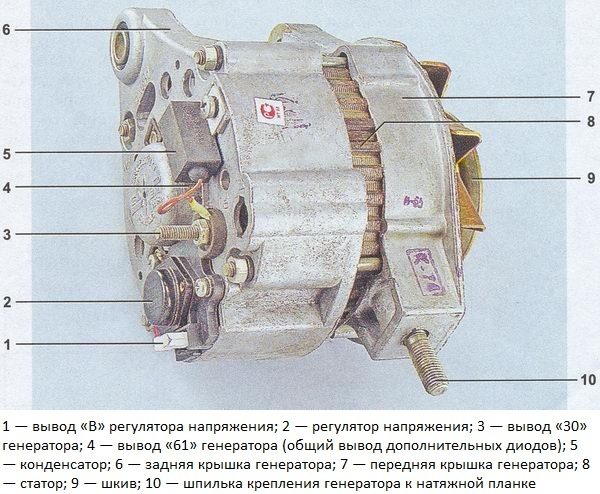
Why does the battery charge disappear on the VAZ 2107
Content
The life of a car battery depends largely on the alternator. It is he who maintains the battery in working condition, charging it with electricity. The slightest malfunction in its operation can damage the battery.
How does the battery charge in the VAZ 2107
To understand how the process of charging the GXNUMX battery takes place, you need to know the principle of operation of the generator and understand the connection diagram of these devices.
Device, drive and characteristics of the VAZ 2107 generator
The automotive generator set is used to provide electricity to the on-board network of the car, as well as to recharge the battery when the power unit is running. Structurally, it consists of the following main elements:
- housings with windings (stator);
- anchors (rotor);
- current conversion module (rectifier);
- stabilizer (voltage regulator).
 The generator is used to provide electricity to the on-board network of the machine
The generator is used to provide electricity to the on-board network of the machine
The unit is driven by a belt from the crankshaft pulley.
Throughout its history, the "sevens" were equipped with two types of generator sets: 372.3701 and 9412.3701. They have a design and principle of operation, except that the fan blades of the 9412.3701 unit are located inside the case, and the rectifier module is outside.
Table: main technical characteristics of VAZ 2107 generator sets
| 372.3701 | 9412.3701 | |
| Rated voltage, V | 14 | 14 |
| Current at rated voltage and armature speed 5000 rpm, A | 55 | 80 |
| Maximum power, W | 770 | 1120 |
| Weight, kg | 4,5 | 4,9 |
The performance of these devices varies greatly in terms of the amount of current produced and the output power. Generator 9412.3701 is more productive. It is used in injection "sevens", where the on-board network is supplemented by an electronic engine control system.
How the VAZ 2107 generator set and the generator circuit work
If you do not delve into the theory of electrical engineering, the generator functions as follows. When the key is turned in the ignition lock, the current from the battery through the relay and the signal lamp of the charge is supplied to the exciting winding of the stator. At the same time, the crankshaft begins to turn the rotor. During the rotation of the armature, an electromagnetic field is formed in the phase windings, which induces an alternating current. Since all electrical appliances of the on-board network are designed for direct current, a semiconductor rectifier module is provided in the design of the installation. The amount of voltage produced by the generator varies depending on the speed of the crankshaft. To stabilize it, a special regulator is used, which smooths out jumps and drops and supplies the vehicle's on-board network with a voltage as close as possible to the nominal voltage.

Thus, with the engine running, the generator converts the torque of the crankshaft into a direct current of 55 or 80 A (depending on the type of device) and a voltage of 13,9–14,5 V, which is necessary for the operation of electrical appliances and battery charging. The current is supplied to the positive terminal of the battery through the output "30" and a separate wire, and the "mass" of the installation is connected to the negative terminal of the battery.
Video: how the generator works
No Charging: Signs and Causes
If for some reason the voltage from the generator stops flowing to the battery, it will be discharged in a few days. And in the event of a complete failure of the battery installation, you will have to provide the entire on-board network, including the ignition system, on your own. So she can work no more than an hour.
Signs of not charging
Symptoms that the alternator is not charging the battery include:
- constantly burning or intermittently turning on the signal lamp on the dashboard;
- fast battery discharge;
- a decrease in the performance of individual electrical devices of the vehicle's on-board network.
signal lamp
On the dashboard of the "seven" there is a special lamp that indicates that the battery is not charging. If the generator circuit is operating normally, the lamp is lit only when the ignition is on until the power unit starts working. After starting the engine, it should go out. If it continues to burn, most likely, the battery is not receiving a charge.


It also happens that the control lamp turns on intermittently. This is a sign that the voltage to the battery is either not supplied at all, or is supplied intermittently.
Fast battery discharge
In the event of a malfunction of the generator or its circuit, the battery will not receive the voltage that is necessary to charge it. In addition, she will have to feed part of the car's electrical equipment, spending her electricity. In such a situation, the battery will quickly sit down. You will be able to understand this when difficulties arise in the process of starting the engine. Receiving insufficient energy, the starter will sluggishly turn the crankshaft flywheel or only “click” the traction relay.
Reduced performance of electrical equipment
To understand that the generator is not operating normally, some electrical appliances will also help. If you suspect a malfunction in the generator set, you can, for example, start the engine, turn on the headlights (if they are equipped with conventional incandescent or halogen lamps) and see how they shine. In the event of a generator malfunction, their brightness will be an order of magnitude lower, because the lamps are also designed for a certain rated current. A decrease in performance can also be observed at the heater fan. It will spin the blades noticeably worse. When it is turned on, the light from the headlights will be even weaker.
Reasons for not charging
There are few reasons for not charging the battery. These include:
- violation of the integrity (breakage) of the drive belt;
- belt loosening;
- breakage in the wiring of the electrical circuit of the generator or strong oxidation of the connecting terminals;
- malfunctions of the rectifier;
- breakdown of the voltage regulator;
- open circuit in the generator windings or short circuit.
Broken belt
Although the belt is designed for 50 thousand kilometers, it can break even after several days of operation. Especially if there are defects in the pulleys of the device itself, the crankshaft or the pump. By itself, a break in the alternator drive belt for the engine is not dangerous, but only if this malfunction is detected immediately. And the point here is not so much in the absence of charging, but in stopping the pump. If it stops working, the engine will instantly overheat. And this is already fraught with burning of the cylinder head gasket with all the ensuing consequences. So in the event of a warning light coming on or other symptoms of alternator malfunction, the first thing to do is to check if the drive belt is intact. To do this, it is necessary to stop the engine, open the hood and make a visual inspection of the generator set drive.
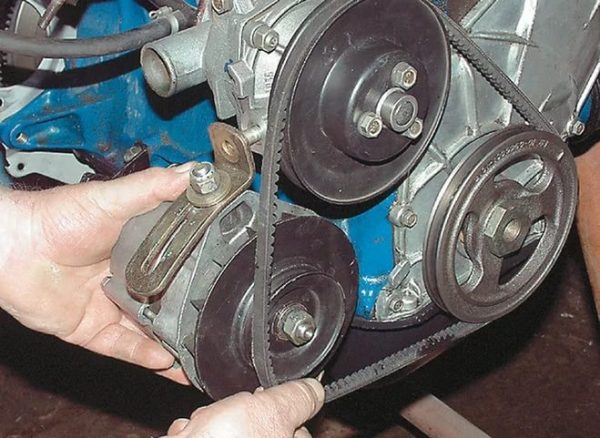

Belt loosening
The drive belt must have a certain tension. When the tension is loosened, it will slip on the crankshaft pulley, not providing the number of revolutions of the generator rotor that is necessary to generate current with the desired parameters. A sign of a loose belt is a characteristic whistle, most often manifested with an increase in air humidity. When the belt slips, the warning light will usually not come on, but in some cases it may turn on for a while or blink.
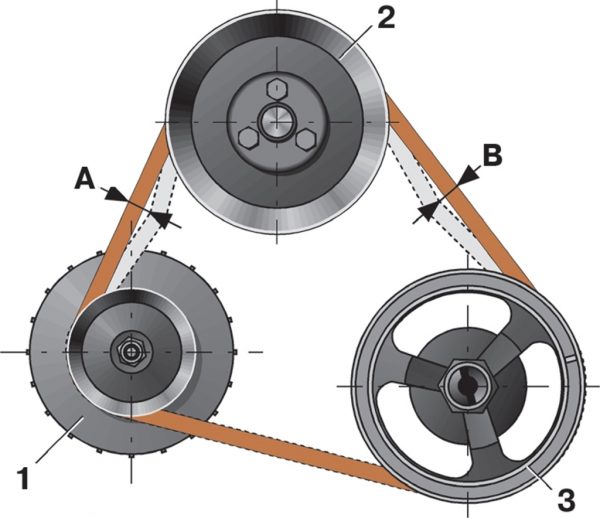

Open circuit and terminal oxidation
The battery will not charge even if the integrity of the wires in the generator connection diagram is broken. The battery charging circuit is quite simple: just one wire connects the positive terminal of the battery to terminal "30" of the generator set. That's where the voltage comes from. The “minus” of the battery is closed to “ground”, to which the generator housing and the corresponding winding terminals are also connected. It is only necessary to check the presence of contact between the indicated points of the circuit.
Oxidation of the battery terminals, as well as their unreliable connection to the wire tips, can also significantly affect the current supply.. You can check the condition of the terminals visually, however, it will not work by eye to determine how the current passes. It is better to once again clean and tighten all wire connections on the battery and generator.
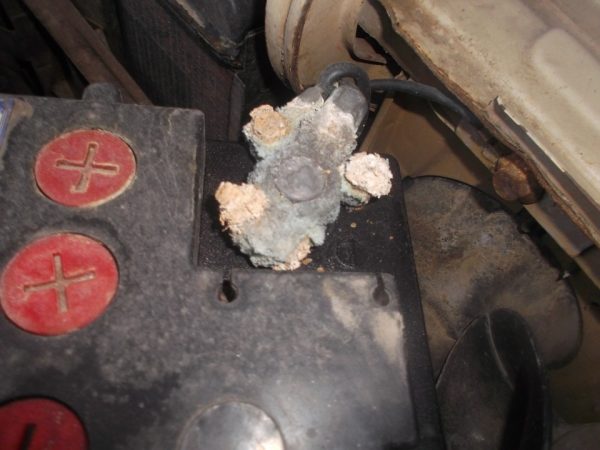

Failure of the rectifier module
If the rectifier fails, the current from the generator to the battery will also not flow. The block itself is a board with six silicon diodes (3 positive and 3 negative). If at least one of them burns out, the rectifier will need to be changed, since it cannot be repaired.


Regulator failure
A stabilizer malfunction is characterized by a change in the characteristics of the current supplied to the battery. In other words, the charging voltage is supplied to the battery, but it is higher or lower than it should be. The regulator is also not repairable and must be replaced in case of failure.


Phase winding failure
If a break occurs in the windings, the generator stops performing its tasks. When an inter-turn short circuit occurs, the installation may behave differently. Usually a sign of such a breakdown is a characteristic smell of burning and a hum during operation. These two malfunctions can be diagnosed only after removing the device from the car. Repair of a generator in the event of an open or short circuit involves the replacement of a burned-out winding or stator assembly.


Diagnostics and repair work
If you suspect that the battery is not charging, you need to perform a series of diagnostic and repair work in this order:
- Stop the car, turn off the engine.
- Raise the hood, check the integrity of the drive belt. If it is intact, check its tension by pressing with a screwdriver or other tool on the belt branch in the middle between the alternator and crankshaft pulleys. The deflection in this place should be 12–17 mm.

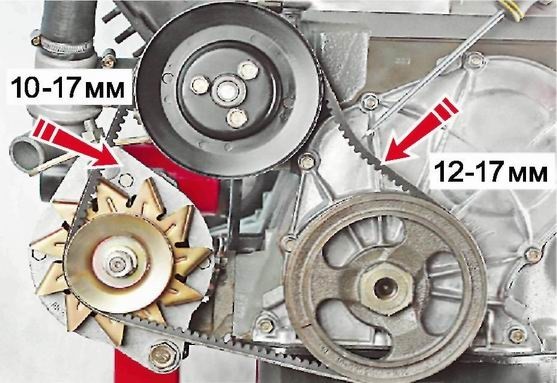 The deflection of the belt branch between the pulleys of the generator and the crankshaft should be 12–17 mm
The deflection of the belt branch between the pulleys of the generator and the crankshaft should be 12–17 mm - If the deflection is greater than the specified value, tighten the belt. To do this, using a 17 mm wrench (for installations of type 9412.3701 with a 13 mm wrench), unscrew the nut that secures the generator to the tension bracket. Use a screwdriver (mount) to move the generator away from the cylinder block. Tighten the nut and re-measure the belt tension.

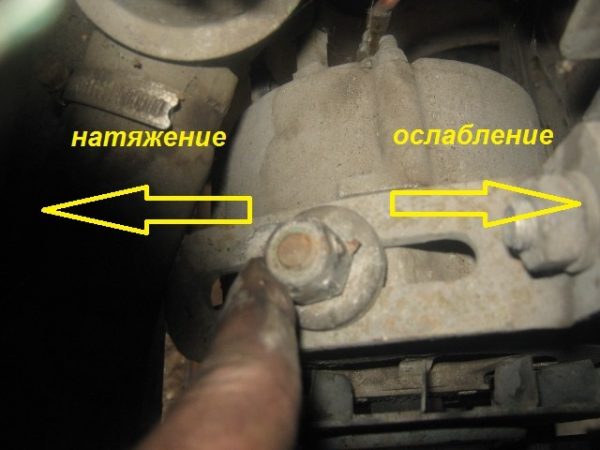 To tighten the belt, you need to unscrew the adjusting nut and move the generator away from the cylinder block
To tighten the belt, you need to unscrew the adjusting nut and move the generator away from the cylinder block - Connect one tester probe. set to the continuity or resistance measurement mode, to the positive terminal of the battery, and the second - to the contact "30" of the generator. If the device does not beep, replace the wire. Next, check the ground by connecting the tester probes to the negative terminal of the battery and the generator housing. If there is no contact, check all connections of the "minus" of the battery with the body and engine. Clean and lubricate mating surfaces (wire lugs, bolts, washers, nuts) with an anti-corrosion agent (WD-40 or equivalent). It is also worth checking the condition of the battery terminals and the reliability of their connection to the wires. In any case, it is better to remove the wires, clean their tips and battery terminals with fine sandpaper and process with WD-40.
- Using a multimeter (voltmeter), measure the voltage at the battery terminals. The device should show 11,7-12,6 V. Then start the engine and repeat the measurements. With a working generator, the voltage at the terminals should be 13,9–14,5 V.

 The voltage at the battery terminals with the engine off should be between 11,7-12,6 V
The voltage at the battery terminals with the engine off should be between 11,7-12,6 V
If the voltage is lower, the cause must be sought in the rectifier, stabilizer or generator windings. In any case, further diagnostics requires the dismantling of the generator.
Video: alternator belt tension


Watch this video on YouTube
Dismantling the generator
To remove the generator set:
- Open the hood, disconnect the wires from the battery.
- Using a 17 mm wrench (for 9412.3701 installations, a 13 mm wrench) completely unscrew the nut fixing the device to the adjusting bracket.

 The adjusting nut is unscrewed with a 13 or 17 mm wrench, depending on the generator model
The adjusting nut is unscrewed with a 13 or 17 mm wrench, depending on the generator model - Move the alternator towards the cylinder block.
- Remove the drive belt.

 When the generator moves closer to the cylinder block, the belt can be removed by hand
When the generator moves closer to the cylinder block, the belt can be removed by hand - Disconnect the terminal block from the device.

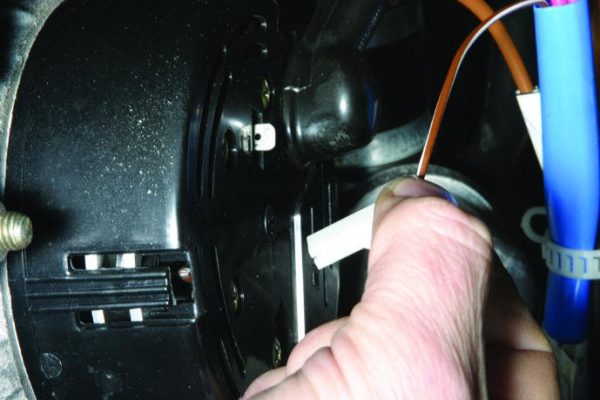 The block is connected to the rear cover of the device (pin D)
The block is connected to the rear cover of the device (pin D) - Remove the protective cap from terminal “30” and use a 10 mm wrench to unscrew the nut that secures the wire terminals. Disconnect the wires, take them to the side.

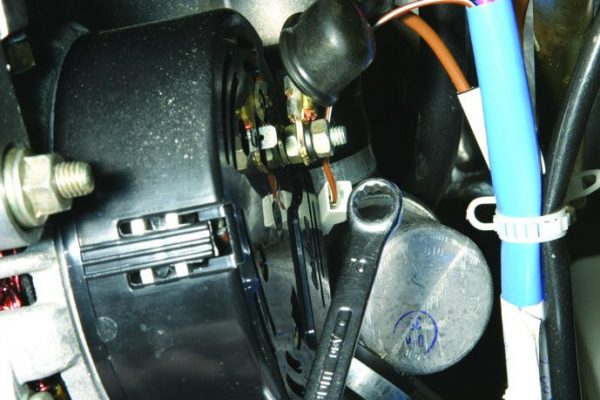 Conclusion "30" of the generator is protected by a rubber cap
Conclusion "30" of the generator is protected by a rubber cap - Using a 13 mm wrench, unscrew the nut securing the unit housing to the bracket on the cylinder block. Remove bolt from bracket.

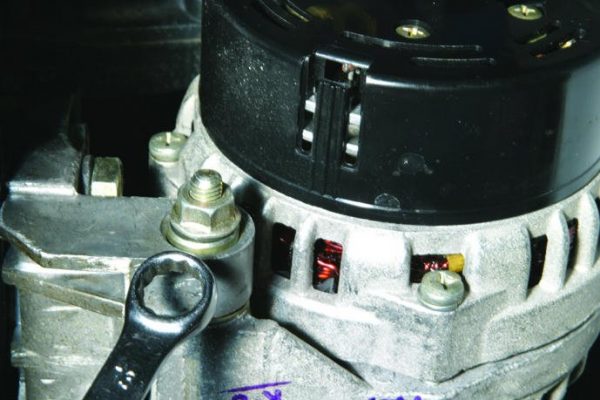 To unscrew the nut, you need a 13 mm wrench
To unscrew the nut, you need a 13 mm wrench - Remove the alternator by lowering it under the vehicle.

 It is necessary to get the generator from under the car
It is necessary to get the generator from under the car
Video: removing the generator


Watch this video on YouTube
Checking the rectifier module, stabilizer and windings
To diagnose the rectifier, regulator and windings, you will need a multimeter and two pieces of wire with clamps. To check, you need to do the following:
- Switch the multimeter to resistance measurement mode.
- Connect the positive probe of the device to terminal “30” of the device, and the negative probe to its “ground”. The resistance between these points may be different, but if it is close to zero, it is possible that the windings are shorted to ground or one of the rectifier diodes is broken.

 The resistance between terminal "30" and the generator housing should not be close to zero
The resistance between terminal "30" and the generator housing should not be close to zero - Check the "positive" diodes of the rectifier for breakdown. To do this, we connect the positive probe to terminal “30”, and the negative probe to any of the bolts that fix the rectifier. If the resistance value tends to zero, there is a breakdown.

 If the resistance between terminal "30" and any of the rectifier mounting bolts is close to zero, one or more positive diodes are broken
If the resistance between terminal "30" and any of the rectifier mounting bolts is close to zero, one or more positive diodes are broken - Check negative diodes. To do this, the positive probe of the device must be connected to one of the rectifier fixing bolts, and the negative probe to the device case. Here, too, the resistance should not be close to zero.

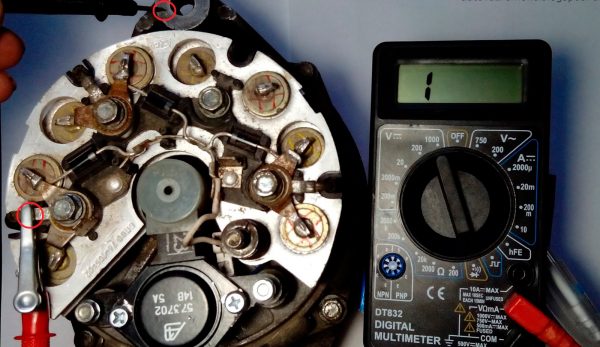 The resistance between the generator housing and the rectifier mounting bolts should also not be close to zero.
The resistance between the generator housing and the rectifier mounting bolts should also not be close to zero. - Check if the rotor winding closes to the housing. Attach the tester probes to the slip ring of the rotor and the generator housing. If current passes between them, the armature must be replaced.

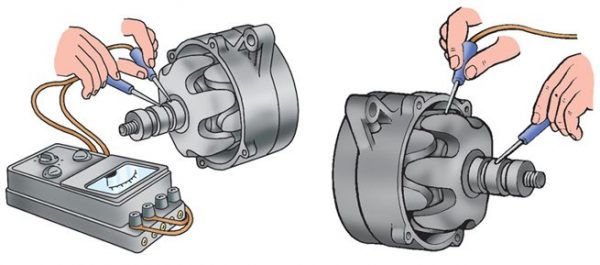 If the resistance between the generator housing and the slip ring is close to zero, there is a short circuit in the rotor winding
If the resistance between the generator housing and the slip ring is close to zero, there is a short circuit in the rotor winding - Remove the voltage regulator by unscrewing the two screws with a Phillips screwdriver.

 The voltage regulator is fixed with two screws for a Phillips screwdriver.
The voltage regulator is fixed with two screws for a Phillips screwdriver. - Remove the device assembly with the brush assembly from the generator housing.
- Assess the condition of the brushes and their mobility. They must be intact, move freely in the brush holders and protrude from them by at least 5 mm.

 The brushes must be intact and move freely in the brush holders.
The brushes must be intact and move freely in the brush holders. - Connect the wire from the positive terminal of the battery to the terminal “B” of the regulator, and connect the wire from the “minus” of the battery to the terminal “A”. Switch the multimeter to voltmeter mode and measure the voltage on the regulator brushes. If there is no voltage, the regulator is defective and must be replaced.

 The voltage on the brushes should be the same as on the battery terminals
The voltage on the brushes should be the same as on the battery terminals
Generator repair
If problems are found with the rectifier module or windings, the defective part must be replaced. This will require:
- Fix the generator impeller with a screwdriver, resting one of the blades on it.
- Using a 19 mm socket or socket wrench, unscrew the pulley fixing nut.

 To unscrew the nut, it is necessary to fix the impeller
To unscrew the nut, it is necessary to fix the impeller - Remove the pulley elements from the shaft of the device.

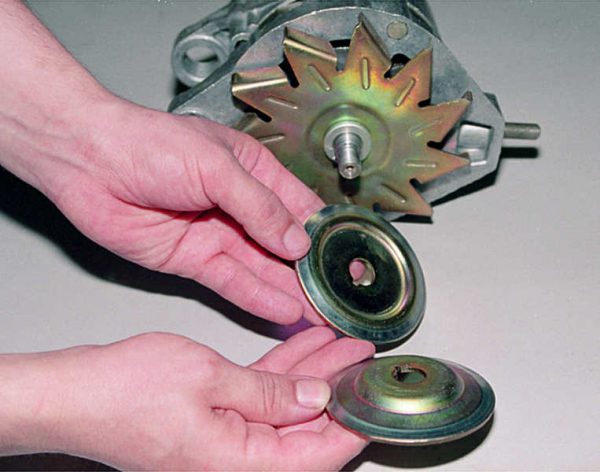 When the nut is unscrewed, all parts must be removed from the shaft
When the nut is unscrewed, all parts must be removed from the shaft - Using a Phillips screwdriver, unscrew the four bolts securing the front and rear covers. Pull out the connecting pins.

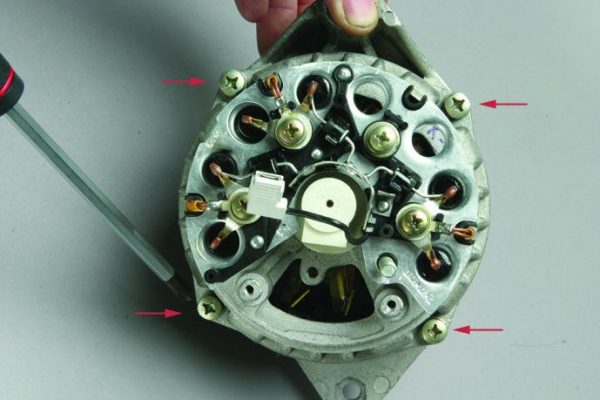 The mounting bolts are unscrewed with a Phillips screwdriver
The mounting bolts are unscrewed with a Phillips screwdriver - Having rested the front cover of the unit on a wooden or plastic block, with light blows on the shaft with a rubber hammer or mallet, knock the cover off the stator.

 The lid is knocked off by applying light blows to the body
The lid is knocked off by applying light blows to the body - Remove the front cover and the sleeve under it.

 There is a spacer under the cover
There is a spacer under the cover - Rest the rear cover of the generator in a vise (you can use two bars) and carefully knock out the rotor from it.

 The rotor is knocked out by light blows of the hammer through the punch
The rotor is knocked out by light blows of the hammer through the punch - With an 8 mm head, unscrew the three nuts that fix the rectifier module and the winding leads. Remove the bolts and windings from the housing.

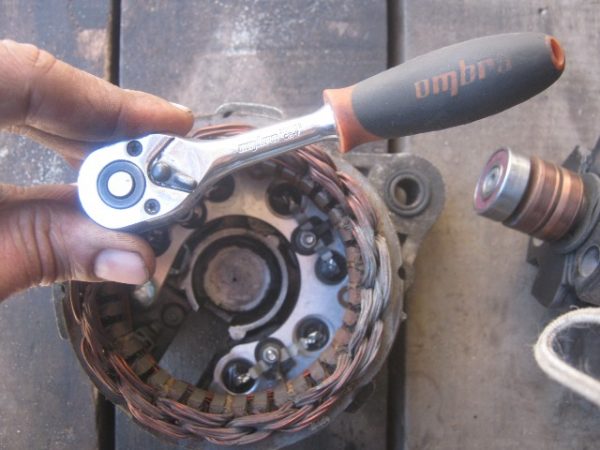 The rectifier module is fixed with three bolts
The rectifier module is fixed with three bolts - Using a 10 mm socket, unscrew the terminal nut “30” of the generator and remove the washer. Remove the rectifier module.
- Replace defective parts with new ones. Reassemble the generator in reverse order.
Video: VAZ 2107 generator repair


Watch this video on YouTube
A few more words about the voltage regulator
Finally, it should be added that in cars such as the VAZ 2107, it is necessary at least once a month to check the voltage supplied from the generator to the battery with a voltmeter. How to do this, we considered above. The fact is that a car device that shows the battery charge level very often lies, showing us the norm, while the voltage at the battery terminals during engine operation is lower or higher than it. And here it is not so much the lack of charging that is dangerous, but the so-called overcharging. It occurs when the voltage regulator malfunctions and is characterized by the supply of voltage to the battery, the value of which is greater than the prescribed value.
Unfortunately, the VAZ 2107 cannot be called a reliable car. But it still has one advantage - simplicity of design. Therefore, it is not necessary to contact specialists in the event of minor malfunctions.

